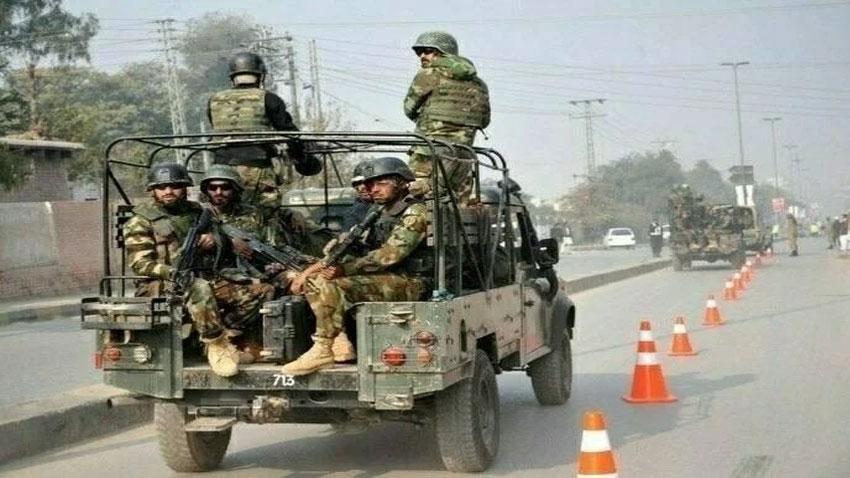Bitter cold has lashed its icy fingers across the United States, bringing a frigid start to the New Year. Dubbed Winter Storm Blair, the tempest has triggered winter weather alerts for more than 60 million people this week in a swath from Illinois to New Jers…

Published a year ago on Jan 8th 2025, 12:00 pm
By Web Desk

Bitter cold has lashed its icy fingers across the United States, bringing a frigid start to the new year. Dubbed Winter Storm Blair, the tempest has triggered winter weather alerts for more than 60 million people this week in a swath from Illinois to New Jersey.
The ongoing storm has already dropped up to a foot of snow in some cities and killed at least six people. As of Monday morning, nearly 300,000 utility customers had lost power across states including Virginia, Kentucky, and Illinois. The storm is forecasted to deliver more snow through Tuesday and frosty weather well into next week. Freezing temperatures are poised to reach as far south as Texas and Florida and could deliver the first snow to Disney World in almost 50 years.
Winter Storm Blair comes as a bookend to one of the hottest years on record, and while it’s freezing North America, its origins actually lie in the Arctic.
There’s evidence that — because of climate change — cold Arctic air may be more likely to break containment in the northernmost reaches of the planet and escape southward, bringing frigid temperatures to lower latitudes like the continental United States.
It may seem counterintuitive, but the fact that global average temperatures are rising does not preclude bouts of cold, and for some Arctic-driven storms, it could exacerbate them. Scientists are examining the mechanisms connecting humanity’s insatiable appetite for fossil fuels, the far north, and storms like Blair. They’re revealing a complicated picture that shows some of the most profound consequences of climate change occur in the chilliest parts of the planet and during the coolest times of year.
As average temperatures rise rapidly, their effects are manifesting in surprising ways, but with more observations and better forecasting tools, storms like Blair don’t have to be so deadly and destructive.
How warming at the North Pole can bring a winter storm to your commute
There are a couple key mechanisms behind chills like Winter Storm Blair. One is the polar vortex, a spinning band of strong, cold wind that is normally confined to 10 to 30 miles above the North Pole. The polar vortex picks up strength during the winter and tends to stay circular, but because of waves in the atmosphere, it can occasionally split into multiple swirls or deform into an oblong shape that reaches outside the Arctic.
The other factor is a jet stream known as the polar jet. This is a band of air blowing west to east at speeds of up to 275 miles per hour at altitudes between 4 and 8 miles above the Earth’s surface.
When the polar jet is strong, it forms a well-defined ring around the Arctic and holds the icy air in place. When it weakens, it wobbles and forms a flower or clover shape when viewed from directly above the North Pole. Within those lobes, cold Arctic air spills over landmasses like Asia and North America.
[Image: The polar jet stream and polar vortex are two rings of fast-moving air around the Arctic that play a large role in world weather patterns. Many climate scientists believe that global warming is changing these rings. https://platform.vox.com/wp-content/uploads/sites/2/2025/01/Polar-Jet-Stream.png?quality=90&strip=all]
Disruptions in the polar vortex can combine with deviations in the polar jet, leading to more cold air reaching even further south.
Such Arctic spillovers, though, have occurred naturally in the past. How does global warming play in? Jennifer Francis, a senior scientist at the Woodwell Climate Research Center, co-authored a review article published in December looking at the body of research trying to answer this question.
The key fact is that while Earth is warming on average, the Arctic is warming up to four times faster than the planet as a whole, a phenomenon called Arctic amplification. That has important knock-on effects.
One is that a warmer Arctic means there is a weaker temperature gradient between the Arctic and its surrounding regions. Francis explained that the steep difference between Arctic and sub-Arctic temperatures is what powers the polar jet in the first place, so as the north begins to feel more like the rest of the planet, the jet gets weaker, making its frigid air more likely to meander across the Northern Hemisphere — and causing more extreme winter storms like Blair.
At the same time, the planet’s oceans have warmed to extraordinary levels in recent years, and some of the planet’s waters, such as the North Pacific Ocean, remain unusually balmy. That’s pushing tropical air further north, bending the jet stream northward over the Pacific and southward over North America.
The loss of sea ice in regions of the Arctic due to warming also has the potential to reshape the polar vortex in ways that lead to more chilly air reaching further south.
Francis and her co-authors acknowledge that there’s a lot of uncertainty in quantifying exactly how much human-caused warming is influencing periods of severe cold. It’s also unclear precisely how this will proceed as the planet keeps heating up.
The effects of warming don’t scale linearly, especially in the Arctic, and there are a lot of complicated feedback mechanisms that researchers are still trying to map out. Melting reflective sea ice, for example, yields to a dark, heat-absorbing ocean that can further melt more ice.
There are also researchers who aren’t convinced that climate change has had a discernible role in recent cold snaps, or that they’ll become more common as global average temperatures rise. One study published last year using climate models and historical records reported that the main way we can see human influence on sudden periods of severe cold is that they aren’t as cold as they used to be. The paper found that cold extremes are warming up faster than average wintertime temperatures in North America.
Scientists generally agree that winters are heating up on average and are warming up faster than summers. Despite this, dangerous winter weather will still, on occasion, spill over from the Arctic. “Even though the Arctic is warming, it will still be frigid during winter for a very long time because it has no sunshine for six months straight,” Francis said in an email. “There will still be plenty of cold air there to feed into cold spells when the jet stream takes a big dip southward.”
Researchers also highlight that the dangers from severe cold waves come not just from the temperature but from how well people are prepared to cope with them. A cold snap can prove deadly if it grips an area that rarely sees such severe chills, as when Winter Storm Uri froze Texas in 2021 and killed 246 people. The threat is amplified when there’s little advance warning.
On this front, there’s a bit of warm comfort in this icy weather. Forecasters are getting a better handle on the warning signs of cold spells. Scientists detected the polar vortex gathering strength last month, and meteorologists were warning since last week that intense cold and snow is in store across much of the United States. With further advances in data gathering and new AI forecasting tools, we’ll likely be able to see the bitter cold more sharply in the future and from farther away.

The 10 most read stories on Future Perfect in 2025
- 10 hours ago

Security forces killed 8 Indian backed terrorists during operations in the Kalat.
- 3 hours ago
Metcalf suspended two games for fan altercation
- 11 hours ago

Civil, military leadership renew pledge to follow Quaid’s vision
- 3 hours ago
Chiefs agree to deal to move to Kansas in 2031
- 11 hours ago

Govt committed to progress, prosperity of minorities: Pm Shebaz
- 3 hours ago

The year the government broke
- 3 hours ago
Pacers hope NBA looks at play that injured Jackson
- 11 hours ago

Apple fined $116 million over app privacy prompts
- 3 hours ago

Dometic makes a better portable water faucet
- 3 hours ago

Field Marshal Asim Munir attends Christmas ceremony, extends greetings to Christian community.
- 32 minutes ago

Christmas: President, PM extend greetings to Christian community
- 3 hours ago
You May Like
Trending













